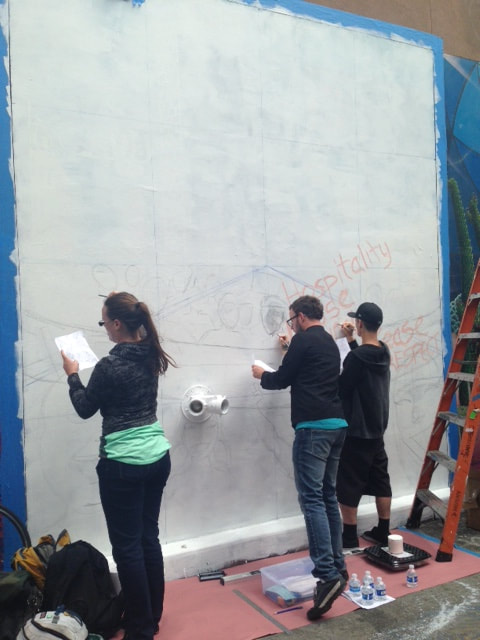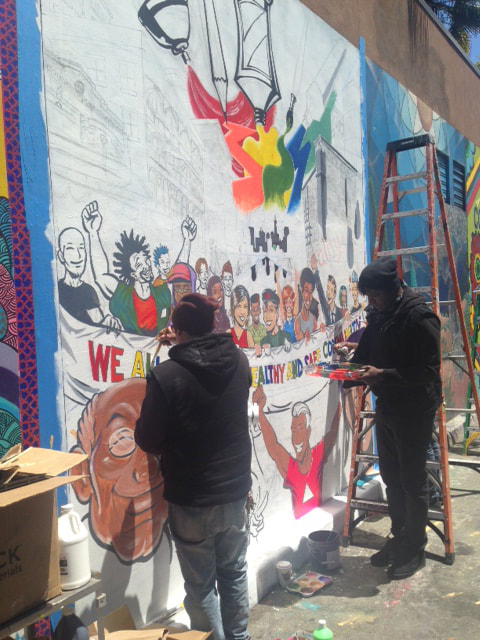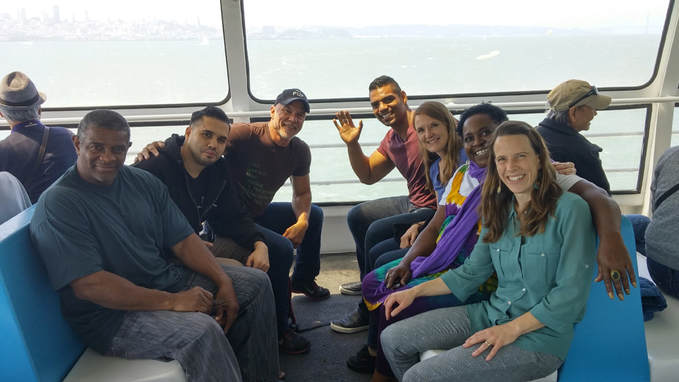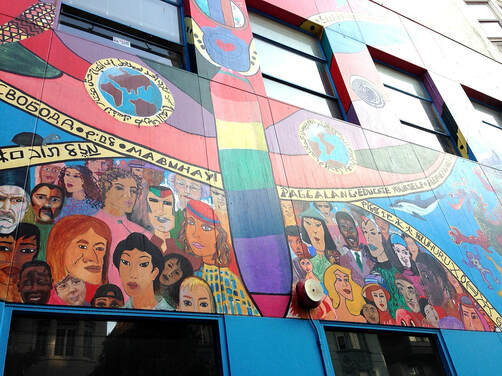2016 Annual Newsletter & Report
[A pdf version of this Annual Newsletter & Report can by downloaded here.]
Visualizing Core Values
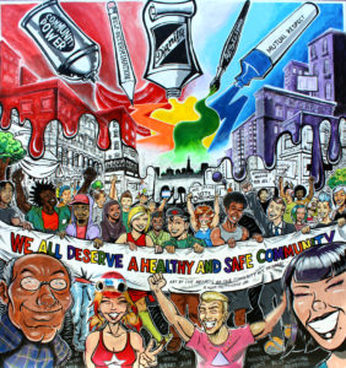
Last March, Community Arts Program Studio Assistant Emma Fenton-Miller was approached by former colleagues Christopher Statton and Megan Wilson, organizers of the Clarion Alley Mural Project (CAMP) about Hospitality House painting a community mural at the very popular Mission District alley. CAMP is a collective of local artists with a mission to support and produce socially engaged and aesthetically diverse public art as a grassroots community-based, artist-run organization in San Francisco.
CAP’s Program Manager, Ivan Vera, worked with Emma and Studio Assistant Robert Chambers to gather about 10 CAP artists committed to working on the project.
Meeting weekly, they decided on a visual that would bring to life the agency’s Theory of Change (TOC). “(On one page) we had those values and framework. We had people look at it and talk about it,” Emma recalls, “Then, we rolled out this giant butcher paper and everybody drew out all these images. We had this central space where you could write words and ideas.”
Robert elaborated on the process. “I did some sketches after accumulating all the input (from the artists). About twelve people had input in what the design should be. It was the community’s artistic voice coming out through the project. ” It only took Robert one day to sketch out all the ideas.
Once the final sketch was approved, Emma and Robert coordinated the field trip to Clarion Alley along with the art supplies. Facing the blank, white wall, the group figured out the proportions and created a grid both on the final sketch and the wall.
“Robert was there to guide people and line it up.” Emma says, “(He) focused on the conceptual and technical aspects. I was amazed that people free handed some of the grid tiles.”
One of the challenges encountered by the group was a double-headed water hydrant jutting out from the lower corner of the wall. The obstacle did not stifle any creativity, though. CAP Artist Sylvester Guard, Jr. turned the hunk of protruding metal into goggles on someone’s head. “He painted it to look like chrome.” says Emma.
After five consecutive days, eight hours each, the mural was complete. From the first meeting when the butcher paper was rolled out to the last painstaking brush stroke, approximately three months had passed.
Following the path of mural’s design from top to bottom, you can spot heavenly art tools representing Hospitality House’s Core Values spilling streams of rainbow colors onto dreary black and white buildings, enlivening the neighborhood and the diverse community of residents who proudly hold a banner proclaiming “WE ALL DESERVE A HEALTHY AND SAFE COMMUNITY” — an echoing sentiment expressed in the TOC.
The mural is scheduled to stay up for at least a year with the possibility of a new mural by CAP replacing it after. Robert hopes the mural continues to get attention. “I hope when people see it, they can understand our message of how many people came together, how the image really represents important goals in the community, like togetherness.”
Emma agrees. “It’s an amazing opportunity for our artists. Our artists are the perfect people for this partnership. It’ll be a really great venue for people to express what’s going on with them, their own personal and political voice. It’s really empowering.”
CAP’s Program Manager, Ivan Vera, worked with Emma and Studio Assistant Robert Chambers to gather about 10 CAP artists committed to working on the project.
Meeting weekly, they decided on a visual that would bring to life the agency’s Theory of Change (TOC). “(On one page) we had those values and framework. We had people look at it and talk about it,” Emma recalls, “Then, we rolled out this giant butcher paper and everybody drew out all these images. We had this central space where you could write words and ideas.”
Robert elaborated on the process. “I did some sketches after accumulating all the input (from the artists). About twelve people had input in what the design should be. It was the community’s artistic voice coming out through the project. ” It only took Robert one day to sketch out all the ideas.
Once the final sketch was approved, Emma and Robert coordinated the field trip to Clarion Alley along with the art supplies. Facing the blank, white wall, the group figured out the proportions and created a grid both on the final sketch and the wall.
“Robert was there to guide people and line it up.” Emma says, “(He) focused on the conceptual and technical aspects. I was amazed that people free handed some of the grid tiles.”
One of the challenges encountered by the group was a double-headed water hydrant jutting out from the lower corner of the wall. The obstacle did not stifle any creativity, though. CAP Artist Sylvester Guard, Jr. turned the hunk of protruding metal into goggles on someone’s head. “He painted it to look like chrome.” says Emma.
After five consecutive days, eight hours each, the mural was complete. From the first meeting when the butcher paper was rolled out to the last painstaking brush stroke, approximately three months had passed.
Following the path of mural’s design from top to bottom, you can spot heavenly art tools representing Hospitality House’s Core Values spilling streams of rainbow colors onto dreary black and white buildings, enlivening the neighborhood and the diverse community of residents who proudly hold a banner proclaiming “WE ALL DESERVE A HEALTHY AND SAFE COMMUNITY” — an echoing sentiment expressed in the TOC.
The mural is scheduled to stay up for at least a year with the possibility of a new mural by CAP replacing it after. Robert hopes the mural continues to get attention. “I hope when people see it, they can understand our message of how many people came together, how the image really represents important goals in the community, like togetherness.”
Emma agrees. “It’s an amazing opportunity for our artists. Our artists are the perfect people for this partnership. It’ll be a really great venue for people to express what’s going on with them, their own personal and political voice. It’s really empowering.”
Clarion Alley is located between 17th and 18th Streets off Mission or Valencia Streets. The Artists of Hospitality House’s Clarion Alley Mural include CAP Staff: Robert Chambers, Emma Fenton-Miller, Txutxo Perez, Josh Reinstein, and Marieke von Rotz. CAP Artists: Billy Crawford, TJ Fisher (Traci), Sylvester Guard Jr., Jo Jackson, Anna Morrow, Eddie Sanchez, Devin Saunders, Tan Sirinumas.
Hospitality House Says Goodbye to Jenny Collins
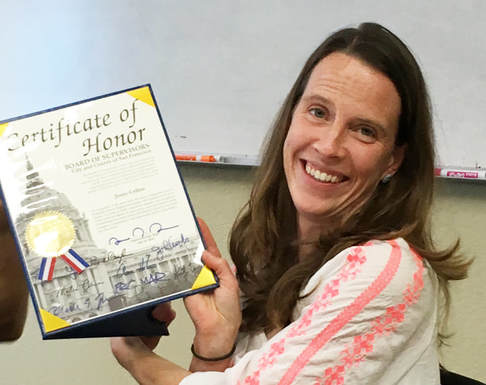
After more than a decade as Hospitality House’s Director of Programs, Jenny Collins has moved on to new adventures. She described her tenure with the organization as transformational. “It shaped me into the person I am today,” she expressed. “Hospitality House will always be a part of me, and it has a special place in my heart.”
Jenny joined the agency after working four years at the Friendship House, a residential substance use treatment program for Native Americans. Her initial application to Hospitality House was not for a Director of Programs position. However, Executive Director Jackie Jenks recognized her potential and after much coaxing, Jenny landed the role. In the decade to follow, Jenny and Jackie worked to enhance and develop the community programs that have made Hospitality House the reputable, grass-roots, community organization it is today.
“So much of what makes Hospitality House great is the spirit and heart that everyone puts into it. And when I say everyone, I mean everyone – ranging from the community members themselves, the participants, to the staff, to the managers,” Jenny extolled, “We supported each other through highs and lows and figured out when we needed to how to be resourceful and make it through the tough times. And there certainly were some dark, tough times. Whether our funding was on the line, or people were going through intense personal crises, you figure out how to dig a little deeper, even if you think you have nothing left to give. And you figure out how to get through, and not only just barely make it through, but really come out on top thriving – so more than surviving, but thriving. And I saw all of us do that for each other countless times. It was just so inspirational, and it was a blessing to be a part of that experience.”
When asked what she was most proud of during her time here (besides her immaculate organizing of the agency’s file room), Jenny talked about the relentless quest for social justice Hospitality House, as a community, continually pursued. “Seeing the transformation that staff brings to people and seeing people say, ‘Oh gosh, I could never do public speaking!’ And then seeing people transformed — being passionate, articulate advocates on the microphone at City Hall or making visits to the (Board of) Supervisors offices and seeing our political process, shaping the SF we want it to be, one that reflects our values. That was wonderful to see happen.”
Jenny is also amazed to see the transformation brought about by the integration of coaching into the agency’s model, particularly with support from Blooming Willow Coaching, and how that connection with leadership works. The lessons from coaching have brought about significant healing and growth for people in their lives — both staff and participants.
On her last day at Hospitality House, Jenny was awarded a glistening crystal plaque with the words “The Emotional Reservoir Award” inscribed on the very top. When asked about the advice she has for anyone who will miss bending her ear or crying on her shoulder, she offered a message of well-being: “Each one of us has to prioritize our own health and wellness and take the steps that we need to make sure that we are nurturing ourselves and doing self care. So many of us at Hospitality House are there because we have a big heart and care about other people, and some of us are not that good about taking the same good care of ourselves. So we have to make sure that we prioritizing that, and we have to make sure we are taking care of each other, too, with the same compassion. Sometimes tension comes up with our co-workers; that’s just natural, but we have to make sure that we are all supporting each other.”
Jenny joined the agency after working four years at the Friendship House, a residential substance use treatment program for Native Americans. Her initial application to Hospitality House was not for a Director of Programs position. However, Executive Director Jackie Jenks recognized her potential and after much coaxing, Jenny landed the role. In the decade to follow, Jenny and Jackie worked to enhance and develop the community programs that have made Hospitality House the reputable, grass-roots, community organization it is today.
“So much of what makes Hospitality House great is the spirit and heart that everyone puts into it. And when I say everyone, I mean everyone – ranging from the community members themselves, the participants, to the staff, to the managers,” Jenny extolled, “We supported each other through highs and lows and figured out when we needed to how to be resourceful and make it through the tough times. And there certainly were some dark, tough times. Whether our funding was on the line, or people were going through intense personal crises, you figure out how to dig a little deeper, even if you think you have nothing left to give. And you figure out how to get through, and not only just barely make it through, but really come out on top thriving – so more than surviving, but thriving. And I saw all of us do that for each other countless times. It was just so inspirational, and it was a blessing to be a part of that experience.”
When asked what she was most proud of during her time here (besides her immaculate organizing of the agency’s file room), Jenny talked about the relentless quest for social justice Hospitality House, as a community, continually pursued. “Seeing the transformation that staff brings to people and seeing people say, ‘Oh gosh, I could never do public speaking!’ And then seeing people transformed — being passionate, articulate advocates on the microphone at City Hall or making visits to the (Board of) Supervisors offices and seeing our political process, shaping the SF we want it to be, one that reflects our values. That was wonderful to see happen.”
Jenny is also amazed to see the transformation brought about by the integration of coaching into the agency’s model, particularly with support from Blooming Willow Coaching, and how that connection with leadership works. The lessons from coaching have brought about significant healing and growth for people in their lives — both staff and participants.
On her last day at Hospitality House, Jenny was awarded a glistening crystal plaque with the words “The Emotional Reservoir Award” inscribed on the very top. When asked about the advice she has for anyone who will miss bending her ear or crying on her shoulder, she offered a message of well-being: “Each one of us has to prioritize our own health and wellness and take the steps that we need to make sure that we are nurturing ourselves and doing self care. So many of us at Hospitality House are there because we have a big heart and care about other people, and some of us are not that good about taking the same good care of ourselves. So we have to make sure that we prioritizing that, and we have to make sure we are taking care of each other, too, with the same compassion. Sometimes tension comes up with our co-workers; that’s just natural, but we have to make sure that we are all supporting each other.”
After completing a coaching certification program through Leadership That Works, Jenny has launched her own coaching business, Nurture Coaching. Although Jenny enjoys coaching anyone interested in personal growth, she focuses her work on new moms and working moms so that they can live in hopefulness and joy. Jenny believes that if we nurture ourselves, we can nurture the world.
Director’s Report: Our community holds the keys to the solutions
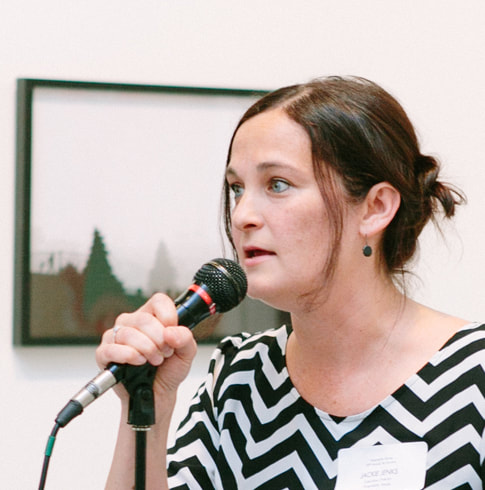
By Jackie Jenks
It has been well over a year since Hospitality House completed our Theory of Change (TOC), a powerful one-page document strategizing the organization’s response to the deafening impacts of a city’s unbridled economic boom. The problem being addressed is boldly stated in our TOC: Relentless economic inequality in San Francisco robs people of the opportunity to live a life of dignity and self-determination and threatens our shared humanity.
Unquestionably, San Francisco’s housing affordability crisis, widening income inequality, and political estrangement have more disproportionate and deeper effects on communities of color, low-income and homeless residents, and renter households. These are the communities that gave birth to Hospitality House nearly a half-century ago, and here is where our story continues. We firmly believe that those who shoulder the burden of the problem hold the keys to the solution.
As our newest chapter begins, Hospitality House has unveiled a bold vision of unlimited possibilities rooted in engaged resident leadership; buttressed by strategic, thoughtful investment in the organization’s full capacity; and fueled by a profound commitment to a future of promise, risk-taking, and discovery.
In response to our TOC problem statement, we identified several anticipated changes that require immediate attention: 1) Preserve our Tenderloin, Sixth Street, and Mid-Market neighborhoods as places where people struggling with poverty are welcome and can thrive; 2) Assure that our low-income residents have affordable housing and meaningful employment; and 3) Build community power so that low-income residents actively participate in making decisions that affect their futures.
Hospitality House is well-positioned to advance strategies that will lead to these changes. Throughout our history, we have developed strong core competency in cultivating peer leadership; building community power through civic engagement and organizing neighborhood residents; and strengthening community alliances to hold decision-makers accountable through policy advocacy.
Cultivating peer leadership
For five decades, Hospitality House has cultivated leaders through our peer model by hiring staff from our communities who have had similar life journeys, lessons learned, and triumphs as those who utilize our programs. The fact that staff share a common experience allows community members seeking services to easily engage, build trust, and take the steps necessary to advance toward their goals. Hospitality House’s peer staff embody real life success stories, proof that anyone can change their lives, rebound from life’s challenges, and transform disadvantaged communities into incubators of opportunity.
We have implemented new ways of supporting and challenging our leaders, created more opportunities for growth and advancement of peers within the organization, and shared our best practices with other organizations. This past year, we have introduced to our staff “Community Coaching” through Blooming Willow Coaching. Community Coaching looks at the resourcefulness and power within communities and uses coaching strategies to support teams and groups to access that power. [Read more about Blooming Willow in this newsletter.]
Building community power through civic engagement and organizing of neighborhood residents.
Now in its sixth year, our Community Building Program (CBP) has had tremendous success developing community leaders through a number of initiatives. The Healing, Organizing and Leadership Development (HOLD) project engages community members with histories of trauma. [Read more about the HOLD project in this newsletter.]
In addition to the HOLD internship, CBP offers other civic engagement and community building opportunities, including “Your City Hall Works for You,” a Civics 101 class led by the Clerk of the San Francisco Board of Supervisors and conducted in the Board Chambers, which educates residents on how municipal government works and how they can impact the process.
The CBP also hosts quarterly community teach-ins and speak-outs on a variety of issues relevant to the community; past topics include homelessness, market rate housing development, propositions on the ballot, plans to develop a Tenderloin flea market, and a special Police Commission meeting on the use of tasers. A weekly Community Organizing Workgroup covers current events and new ideas for organizing residents, and a quarterly “Talking Tech in the Tenderloin” event brings tech company employees together with community residents in an informal, non-traditional setting to promote dialogue and work together toward positive change.
Strengthening community alliances.
Throughout our history, Hospitality House has formed and participated in many community alliances to influence policy decisions and prioritize funding for people struggling with homelessness and poverty in our neighborhoods.
Presently, Hospitality House co-chairs three collaborations which we also co-founded:
Market Street for the Masses Coalition, the Homeless Emergency Service Providers Association, and the Homeless Employment Collaborative.
In addition to our leadership in these groups, Hospitality House participates in a number of other collaborative efforts across San Francisco to strengthen service delivery for our residents and advocate for policies that impact our community. These include the Human Services Network, the Community Partnership for a Healthier Tenderloin, the Budget Justice Coalition, Jobs with Justice, and the Western Regional Advocacy Project.
As Hospitality House approaches our 50 years as a community institution in the heart of San Francisco, we are determined to enhance our innovative hybrid organizing model that blends direct services with grassroots organizing, civic engagement, and empowerment for community residents. We must take bold action during this time of dramatic and lasting change to preserve San Francisco’s vibrant, diverse low-income communities, build community strength, and work toward economic equality.
It has been well over a year since Hospitality House completed our Theory of Change (TOC), a powerful one-page document strategizing the organization’s response to the deafening impacts of a city’s unbridled economic boom. The problem being addressed is boldly stated in our TOC: Relentless economic inequality in San Francisco robs people of the opportunity to live a life of dignity and self-determination and threatens our shared humanity.
Unquestionably, San Francisco’s housing affordability crisis, widening income inequality, and political estrangement have more disproportionate and deeper effects on communities of color, low-income and homeless residents, and renter households. These are the communities that gave birth to Hospitality House nearly a half-century ago, and here is where our story continues. We firmly believe that those who shoulder the burden of the problem hold the keys to the solution.
As our newest chapter begins, Hospitality House has unveiled a bold vision of unlimited possibilities rooted in engaged resident leadership; buttressed by strategic, thoughtful investment in the organization’s full capacity; and fueled by a profound commitment to a future of promise, risk-taking, and discovery.
In response to our TOC problem statement, we identified several anticipated changes that require immediate attention: 1) Preserve our Tenderloin, Sixth Street, and Mid-Market neighborhoods as places where people struggling with poverty are welcome and can thrive; 2) Assure that our low-income residents have affordable housing and meaningful employment; and 3) Build community power so that low-income residents actively participate in making decisions that affect their futures.
Hospitality House is well-positioned to advance strategies that will lead to these changes. Throughout our history, we have developed strong core competency in cultivating peer leadership; building community power through civic engagement and organizing neighborhood residents; and strengthening community alliances to hold decision-makers accountable through policy advocacy.
Cultivating peer leadership
For five decades, Hospitality House has cultivated leaders through our peer model by hiring staff from our communities who have had similar life journeys, lessons learned, and triumphs as those who utilize our programs. The fact that staff share a common experience allows community members seeking services to easily engage, build trust, and take the steps necessary to advance toward their goals. Hospitality House’s peer staff embody real life success stories, proof that anyone can change their lives, rebound from life’s challenges, and transform disadvantaged communities into incubators of opportunity.
We have implemented new ways of supporting and challenging our leaders, created more opportunities for growth and advancement of peers within the organization, and shared our best practices with other organizations. This past year, we have introduced to our staff “Community Coaching” through Blooming Willow Coaching. Community Coaching looks at the resourcefulness and power within communities and uses coaching strategies to support teams and groups to access that power. [Read more about Blooming Willow in this newsletter.]
Building community power through civic engagement and organizing of neighborhood residents.
Now in its sixth year, our Community Building Program (CBP) has had tremendous success developing community leaders through a number of initiatives. The Healing, Organizing and Leadership Development (HOLD) project engages community members with histories of trauma. [Read more about the HOLD project in this newsletter.]
In addition to the HOLD internship, CBP offers other civic engagement and community building opportunities, including “Your City Hall Works for You,” a Civics 101 class led by the Clerk of the San Francisco Board of Supervisors and conducted in the Board Chambers, which educates residents on how municipal government works and how they can impact the process.
The CBP also hosts quarterly community teach-ins and speak-outs on a variety of issues relevant to the community; past topics include homelessness, market rate housing development, propositions on the ballot, plans to develop a Tenderloin flea market, and a special Police Commission meeting on the use of tasers. A weekly Community Organizing Workgroup covers current events and new ideas for organizing residents, and a quarterly “Talking Tech in the Tenderloin” event brings tech company employees together with community residents in an informal, non-traditional setting to promote dialogue and work together toward positive change.
Strengthening community alliances.
Throughout our history, Hospitality House has formed and participated in many community alliances to influence policy decisions and prioritize funding for people struggling with homelessness and poverty in our neighborhoods.
Presently, Hospitality House co-chairs three collaborations which we also co-founded:
Market Street for the Masses Coalition, the Homeless Emergency Service Providers Association, and the Homeless Employment Collaborative.
In addition to our leadership in these groups, Hospitality House participates in a number of other collaborative efforts across San Francisco to strengthen service delivery for our residents and advocate for policies that impact our community. These include the Human Services Network, the Community Partnership for a Healthier Tenderloin, the Budget Justice Coalition, Jobs with Justice, and the Western Regional Advocacy Project.
As Hospitality House approaches our 50 years as a community institution in the heart of San Francisco, we are determined to enhance our innovative hybrid organizing model that blends direct services with grassroots organizing, civic engagement, and empowerment for community residents. We must take bold action during this time of dramatic and lasting change to preserve San Francisco’s vibrant, diverse low-income communities, build community strength, and work toward economic equality.
Bloom Wherever You’re Planted
Through a new grant from the Community Innovation Fund, a partnership between The San Francisco Foundation, the California Pacific Medical Center, and the San Francisco Department of Public Health, Hospitality House was able to partner this past year with Blooming Willow Coaching, a group that inspires and motivates individuals and teams to move from where they are to where they want to be through “Community Coaching.”
What is Community Coaching?
Through a new grant from the Community Innovation Fund, a partnership between The San Francisco Foundation, the California Pacific Medical Center, and the San Francisco Department of Public Health, Hospitality House was able to partner this past year with Blooming Willow Coaching, a group that inspires and motivates individuals and teams to move from where they are to where they want to be through “Community Coaching.”
What is Community Coaching?

“Community Coaching looks at the resourcefulness and power within communities and really uses coaching strategies to support teams and groups to access that power,” says Leslie Brown, Blooming Willow’s owner and co-designer. “With Blooming Willow, we take it a step further in that we use a trauma-informed approach which takes into account people’s lived experiences and really looks at them as the experts on how to develop systems, strategies, tools to support them in their work.” Bloom wherever you’re planted is their motto.
If this sounds familiar, it’s because the approach aligns with Hospitality House’s Organizational Strategies listed in the agency’s Theory of Change:
“Prioritize personal experiences as a source of knowledge and wisdom to share with others.”
“Our approaches align especially in the way Hospitality House interacts with the community, the way you are part of the community, as peers, “ adds Nicky Avant, one of the co-designers at Blooming Willow. “As consultants and coaches coming into the organization, we see our role as being able to continue to hold that — ‘meeting people where they are.’”
If this sounds familiar, it’s because the approach aligns with Hospitality House’s Organizational Strategies listed in the agency’s Theory of Change:
“Prioritize personal experiences as a source of knowledge and wisdom to share with others.”
“Our approaches align especially in the way Hospitality House interacts with the community, the way you are part of the community, as peers, “ adds Nicky Avant, one of the co-designers at Blooming Willow. “As consultants and coaches coming into the organization, we see our role as being able to continue to hold that — ‘meeting people where they are.’”
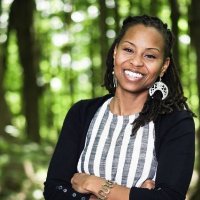 Nicky Avant
Nicky Avant
A typical coaching session generally includes defining the challenge the person wants to address, exploring what it would take to resolve the issue, identifying what gaps and opportunities are present, and coming up with action steps.
Shaking up creativity
The coaching sessions from Blooming Willow have been transformational for Hospitality House staff. “What I saw at Hospitality House was typical of other developing coaching cultures,” says Leslie. “It starts with the individual feeling renewed and refreshed, reducing burnout, allowing people to get more in touch with what they’re really wanting out of their jobs, out of their lives — as one part. The other part is that it does shake up creativity. People bring in fresh ideas, and new ways of doing the work start to arrive. They become those problem solvers, understanding their roles as change makers.”
Nicky elaborates on the impact, “After people really understood what (coaching) was and how they can tap into it, I saw this expanding of their view. They begin challenging their current beliefs of what’s possible. They understand that they have much more wiggle room. And then the empowerment phase comes in, where they are getting deeper into those limiting beliefs and start to bring creativity into play. As they bring in creativity, they become more resourceful; they start to generate new ideas; they start to create plans, strategies that can assist them towards accomplishing their goals.”
Sixth Street Program Manager Kenya Hatcher has embraced coaching, “It has open the doors of possibilities for me in the areas of spirituality, empowerment and education. ”
Shaking up creativity
The coaching sessions from Blooming Willow have been transformational for Hospitality House staff. “What I saw at Hospitality House was typical of other developing coaching cultures,” says Leslie. “It starts with the individual feeling renewed and refreshed, reducing burnout, allowing people to get more in touch with what they’re really wanting out of their jobs, out of their lives — as one part. The other part is that it does shake up creativity. People bring in fresh ideas, and new ways of doing the work start to arrive. They become those problem solvers, understanding their roles as change makers.”
Nicky elaborates on the impact, “After people really understood what (coaching) was and how they can tap into it, I saw this expanding of their view. They begin challenging their current beliefs of what’s possible. They understand that they have much more wiggle room. And then the empowerment phase comes in, where they are getting deeper into those limiting beliefs and start to bring creativity into play. As they bring in creativity, they become more resourceful; they start to generate new ideas; they start to create plans, strategies that can assist them towards accomplishing their goals.”
Sixth Street Program Manager Kenya Hatcher has embraced coaching, “It has open the doors of possibilities for me in the areas of spirituality, empowerment and education. ”
Ripples
With two years of renewed funding through the Innovation Fund, Hospitality House is poised to expand Community Coaching as an model to strengthen the community by teaching participants of our community programs coaching skills. So far, the energy is there.
“The thing that I’ve seen ripple from this partnership has been that energy from the Hospitality House team,” says Leslie. “During the trainings you can feel it. It’s really powerful. For all the trainers and coaches that get to support this work from Blooming Willow, they all talk about how they can feel the energy of this group and how it really inspires them as coaches, as trainers, to do this work. I think that’s the really cool thing. Hospitality House makes everyone feel welcomed and able to see themselves in the work. To be able to support this work has been transformational for OUR team.”
For more information on Blooming Willow, click here
With two years of renewed funding through the Innovation Fund, Hospitality House is poised to expand Community Coaching as an model to strengthen the community by teaching participants of our community programs coaching skills. So far, the energy is there.
“The thing that I’ve seen ripple from this partnership has been that energy from the Hospitality House team,” says Leslie. “During the trainings you can feel it. It’s really powerful. For all the trainers and coaches that get to support this work from Blooming Willow, they all talk about how they can feel the energy of this group and how it really inspires them as coaches, as trainers, to do this work. I think that’s the really cool thing. Hospitality House makes everyone feel welcomed and able to see themselves in the work. To be able to support this work has been transformational for OUR team.”
For more information on Blooming Willow, click here
Turning Trauma into Triumph Together: The H.O.L.D. Program
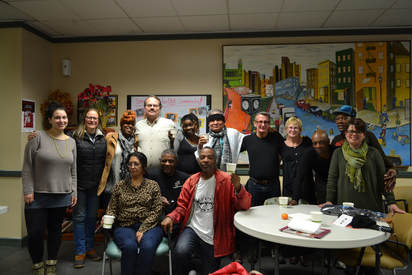
Graduates from the Healing, Organizing, and Leadership Development program (HOLD) posed for a photo holding up framed certificates, presented to them by Joe Wilson, Program Manager of Hospitality House’s Community Building Program (CBP), along with a book of inspirational reading and accolades from everyone in the room.
Organized into cohorts of six to ten individuals for a twice-weekly, four-month training series, participants of HOLD learn about trauma’s effects on individuals and communities, gain practical tools to manage trauma and learn more healthful practices, and develop ways in which they can affect change in their communities.
The HOLD program model utilizes the expertise of community partners such as Mission Neighborhood Resource Center, the Community Housing Partnership, and the Harm Reduction Therapy Center, and weaves together principles of popular education, community organizing, small group discussion, and harm reduction philosophy. “ Believing that people can, showing people how, helping people do,” says Program Manager Joe Wilson. Since its founding in Fall 2010, HOLD has nearly 75 graduates, many of whom are inspirational leaders who are mentors to other emerging leaders.
The Power of Story
The four-month, bi-weekly program begins with the use of The Power of Story, modeled after Harvard University Professor Marshall Ganz’s famed Organizing Institute course, where students reflect upon their leadership capacities through a discursive, storytelling process.
“At first, people are scared of judgment and saying what their struggles actually are. Sometimes, we don’t want to [admit] to our struggles,” says Windy Click, one of CBP’s Peer Advocates, “But then Joe shares part of his story, and it starts a newer understanding that we’ve all faced struggles of trauma in our lives. They’ve all had some time of struggle that relates to each other.” After the Power of Story session, staff from the HH Community Arts Program guides HOLD participants in using creative arts and various media to bring their personal stories to life.
Trauma And Recovery
The landmark text, Trauma and Recovery by Judith Herman, MD, is central to the HOLD program’s exploration of psychological trauma. Though more than 20 years old, Trauma and Recovery is renowned for making the connection between trauma experienced by combat veterans and survivors of domestic violence. Based on actual case studies drawn primarily from Herman’s two decades of work as a mental health clinician, participants are able to recognize part of their own histories and their own traumatic experiences, as well as the fundamental changes and behavior patterns re-wired into the brain due to unresolved trauma.
“That’s part of the healing process,“ says Joe, “There’s discussion around the biology of trauma, changes that happen in the brain – and the hopefulness of recovery and renewal.”
Every Friday, the group has a session with a trained therapist rom the Harm Reduction Therapy Center to process the previous week’s discussion. Discussion of personal trauma often involves revisiting certain traumatic experiences, which requires ongoing support. “We’ve learned over time that folks aren’t simply remembering traumatic experiences – they’re actually reliving them,” Joe explains, “We have to take it very seriously.”
Community Organizing
CBP Peer Advocate Herlinda Aguirre outlines the next steps of HOLD: “In addition to learning [some of] the somatic triggers and how to manage them, we also give folks the tools of community organizing and civic engagement. Then they can bring back the things that they learn [with] tools to organize within their community.”
Organized into cohorts of six to ten individuals for a twice-weekly, four-month training series, participants of HOLD learn about trauma’s effects on individuals and communities, gain practical tools to manage trauma and learn more healthful practices, and develop ways in which they can affect change in their communities.
The HOLD program model utilizes the expertise of community partners such as Mission Neighborhood Resource Center, the Community Housing Partnership, and the Harm Reduction Therapy Center, and weaves together principles of popular education, community organizing, small group discussion, and harm reduction philosophy. “ Believing that people can, showing people how, helping people do,” says Program Manager Joe Wilson. Since its founding in Fall 2010, HOLD has nearly 75 graduates, many of whom are inspirational leaders who are mentors to other emerging leaders.
The Power of Story
The four-month, bi-weekly program begins with the use of The Power of Story, modeled after Harvard University Professor Marshall Ganz’s famed Organizing Institute course, where students reflect upon their leadership capacities through a discursive, storytelling process.
“At first, people are scared of judgment and saying what their struggles actually are. Sometimes, we don’t want to [admit] to our struggles,” says Windy Click, one of CBP’s Peer Advocates, “But then Joe shares part of his story, and it starts a newer understanding that we’ve all faced struggles of trauma in our lives. They’ve all had some time of struggle that relates to each other.” After the Power of Story session, staff from the HH Community Arts Program guides HOLD participants in using creative arts and various media to bring their personal stories to life.
Trauma And Recovery
The landmark text, Trauma and Recovery by Judith Herman, MD, is central to the HOLD program’s exploration of psychological trauma. Though more than 20 years old, Trauma and Recovery is renowned for making the connection between trauma experienced by combat veterans and survivors of domestic violence. Based on actual case studies drawn primarily from Herman’s two decades of work as a mental health clinician, participants are able to recognize part of their own histories and their own traumatic experiences, as well as the fundamental changes and behavior patterns re-wired into the brain due to unresolved trauma.
“That’s part of the healing process,“ says Joe, “There’s discussion around the biology of trauma, changes that happen in the brain – and the hopefulness of recovery and renewal.”
Every Friday, the group has a session with a trained therapist rom the Harm Reduction Therapy Center to process the previous week’s discussion. Discussion of personal trauma often involves revisiting certain traumatic experiences, which requires ongoing support. “We’ve learned over time that folks aren’t simply remembering traumatic experiences – they’re actually reliving them,” Joe explains, “We have to take it very seriously.”
Community Organizing
CBP Peer Advocate Herlinda Aguirre outlines the next steps of HOLD: “In addition to learning [some of] the somatic triggers and how to manage them, we also give folks the tools of community organizing and civic engagement. Then they can bring back the things that they learn [with] tools to organize within their community.”
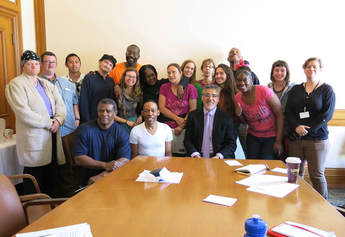 Members of HOLD with Supervisor John Avalos
Members of HOLD with Supervisor John Avalos
The Graduates
Joe, Windy, and Herlinda are very proud of the accomplishments of past HOLD graduates. Two graduates are on Hospitality House’s Board of Directors, one hosts her own television and radio program, two others are now elected leaders of their tenants’ association. One graduate was appointed to one of the City’s formal advisory bodies for the Tenderloin. At least two graduates have been hired as Hospitality House peer staff. Dozens of HOLD graduates have testified at Citywide public hearings, community forums, and neighborhood meetings – many for the first time ever.
Additionally, graduates of HOLD return to lead one or more workshop sessions with newer HOLD participants, offering their experiences as examples of the healing potential within us.
An Acknowledgment of Our Humanity
Joe sums up the essence of HOLD: “ Well, it really is the diversity of humanity that we see and the longing for each individual to be accepted and acknowledged in some way. I think in big ways and little ways, that’s what the program has been for many of us, an acknowledgment of each other’s humanity. At its best, it’s what a community institution should be, a place for belonging and affirmation of the best in each of us.”
Turning trauma into triumph, together. Indeed.
Joe, Windy, and Herlinda are very proud of the accomplishments of past HOLD graduates. Two graduates are on Hospitality House’s Board of Directors, one hosts her own television and radio program, two others are now elected leaders of their tenants’ association. One graduate was appointed to one of the City’s formal advisory bodies for the Tenderloin. At least two graduates have been hired as Hospitality House peer staff. Dozens of HOLD graduates have testified at Citywide public hearings, community forums, and neighborhood meetings – many for the first time ever.
Additionally, graduates of HOLD return to lead one or more workshop sessions with newer HOLD participants, offering their experiences as examples of the healing potential within us.
An Acknowledgment of Our Humanity
Joe sums up the essence of HOLD: “ Well, it really is the diversity of humanity that we see and the longing for each individual to be accepted and acknowledged in some way. I think in big ways and little ways, that’s what the program has been for many of us, an acknowledgment of each other’s humanity. At its best, it’s what a community institution should be, a place for belonging and affirmation of the best in each of us.”
Turning trauma into triumph, together. Indeed.
Have you been to Cafe 146? The Tenderloin Self-Help Center gets a new look.
 The floor before…
The floor before…
There’s a vibrancy in the air as soon as you step through the doors of 146 Leavenworth Street — a sense of rejuvenation that goes beyond the freshly painted walls, the new tables, or even the glimmering, refinished floors.
“It went from a drop-in center to more like a café. There’s more dignity to the space.” explains David McKinley, Program Manager of the newly refurbished Tenderloin Self-Help Center.
“We were really surprised about how impactful it was for our community. The new floor and the new walls was a statement from the agency that they care about the participants; they want people to have a space that is their home – one that’s nice and taken care of.”
During a ten-day period which included a Labor Day weekend, the Self-Help Center underwent its first facelift in four years. The dingy, battered cement floor was replaced with a sandy-colored, durable material that will be much easier to maintain and that shimmers under the center’s florescent lights. Strips of chair guard railing were installed on the previously scuffed walls before fresh coats of white paint were applied. Several round communal tables were brought in to change the dynamics of the room.
“Introducing the new furniture included this element of dignity where people weren’t just slumped over in chairs, crammed next to each other,” David points out. “Now people have their own space – they can read, they can study, they can share.”
In just a matter of weeks, he has noticed a change in the way participants relate to each other. The new arrangement has created an environment that cultivates more community. “We’ve had a lot of peace and more interaction because people are sitting at tables. People who don’t know each other are engaging in conversation.”
David’s next plan is to activate the mezzanine level. He has already collaborated with the Employment Program in hosting hiring and training events in the under-utilized area above the main floor, a move that has created more visibility for the program. “We can literally point to the mezzanine from the floor to direct people who are looking for jobs.”
Besides adding new couches, workspaces, plants, and a lending library, David envisions using the mezzanine as a space for personal development training among the staff which includes skills building with a focus on self-empowerment, addressing trauma, peer-coaching, and learning about the power of choice.
“It went from a drop-in center to more like a café. There’s more dignity to the space.” explains David McKinley, Program Manager of the newly refurbished Tenderloin Self-Help Center.
“We were really surprised about how impactful it was for our community. The new floor and the new walls was a statement from the agency that they care about the participants; they want people to have a space that is their home – one that’s nice and taken care of.”
During a ten-day period which included a Labor Day weekend, the Self-Help Center underwent its first facelift in four years. The dingy, battered cement floor was replaced with a sandy-colored, durable material that will be much easier to maintain and that shimmers under the center’s florescent lights. Strips of chair guard railing were installed on the previously scuffed walls before fresh coats of white paint were applied. Several round communal tables were brought in to change the dynamics of the room.
“Introducing the new furniture included this element of dignity where people weren’t just slumped over in chairs, crammed next to each other,” David points out. “Now people have their own space – they can read, they can study, they can share.”
In just a matter of weeks, he has noticed a change in the way participants relate to each other. The new arrangement has created an environment that cultivates more community. “We’ve had a lot of peace and more interaction because people are sitting at tables. People who don’t know each other are engaging in conversation.”
David’s next plan is to activate the mezzanine level. He has already collaborated with the Employment Program in hosting hiring and training events in the under-utilized area above the main floor, a move that has created more visibility for the program. “We can literally point to the mezzanine from the floor to direct people who are looking for jobs.”
Besides adding new couches, workspaces, plants, and a lending library, David envisions using the mezzanine as a space for personal development training among the staff which includes skills building with a focus on self-empowerment, addressing trauma, peer-coaching, and learning about the power of choice.
|
“My dream is to have staff teach participants to create community transformation through coaching and community engagement. The core group of staff coaches who intensely engage with each other then, in turn, train participants to coach and engage each other to reach community transformation. That is the long-term vision for the Self-Help Center, as ambitious as it is.” David laughs.
|
Program Outcomes (July 1, 2015 thru June 30, 2016)
TENDERLOIN SELF-HELP CENTER
12,484 individuals served
246 participants implemented strategies to reduce harm
121 participants had a case plan
101 participants achieved at least one case plan goal
SIXTH STREET SELF-HELP CENTER
4,809 individuals served
108 participants attended Harm Reduction support groups
99 participants were linked to behavioral health services
22 participants enrolled in case management obtained positive placements in housing, employment, school, or a job training program
COMMUNITY BUILDING PROGRAM
345 community members participated in 16 community events
16 interns enrolled in the Healing, Organizing and Leadership Development (HOLD)
84 participants implemented strategies to reduce harm
116 participants enrolled in case management obtained positive placements in housing, employment, school, or a job training program
COMMUNITY ARTS PROGRAM
1,887 individual artists and neighborhood residents created artwork at CAP last year, for a total of 4,055 visits
92 workshops were offered
10 exhibitions were held at the CAP gallery and other locations
EMPLOYMENT PROGRAM
119 participants enrolled in employment services
109 participants completed job search activities
56 participants obtained job placement
12 participants were placed into training programs or post-secondary education
SHELTER PROGRAM
The shelter provided services to 667 homeless men
84 men received extended case management
18 residents moved into housing
24 residents addressed their health care needs
TENDERLOIN SELF-HELP CENTER
12,484 individuals served
246 participants implemented strategies to reduce harm
121 participants had a case plan
101 participants achieved at least one case plan goal
SIXTH STREET SELF-HELP CENTER
4,809 individuals served
108 participants attended Harm Reduction support groups
99 participants were linked to behavioral health services
22 participants enrolled in case management obtained positive placements in housing, employment, school, or a job training program
COMMUNITY BUILDING PROGRAM
345 community members participated in 16 community events
16 interns enrolled in the Healing, Organizing and Leadership Development (HOLD)
84 participants implemented strategies to reduce harm
116 participants enrolled in case management obtained positive placements in housing, employment, school, or a job training program
COMMUNITY ARTS PROGRAM
1,887 individual artists and neighborhood residents created artwork at CAP last year, for a total of 4,055 visits
92 workshops were offered
10 exhibitions were held at the CAP gallery and other locations
EMPLOYMENT PROGRAM
119 participants enrolled in employment services
109 participants completed job search activities
56 participants obtained job placement
12 participants were placed into training programs or post-secondary education
SHELTER PROGRAM
The shelter provided services to 667 homeless men
84 men received extended case management
18 residents moved into housing
24 residents addressed their health care needs
Financials for Fiscal Year 2015-16
INCOME |
|
Federal Funding |
305,328.70 |
State Funding |
1,119,514.00 |
Local Funding |
1,944,444.08 |
Foundations |
254,450.00 |
Corporations |
47,032.46 |
Individual |
66,984.99 |
Other |
195,702.11 |
Total |
3,933.456.34 |
EXPENSES |
|
Program Personnel |
2,514,595.60 |
Admin Personnel |
24,697.43 |
Client/Consulting Serv. |
636,370.93 |
Office & Facility |
704,392.90 |
Fundraising |
30,192.89 |
Staff Training & Dev. |
39,749.34 |
Total |
3,949,999.09 |
NET INCOME |
(16,542.75) |
Non cash Items: |
|
Depreciation/Amorit. |
169,151.76 |
Net Income before non-cash items |
152,609.01 |
We would like to express our deepest gratitude to all our donors, sponsors, in-kind donors, foundations, and community partners who support Hospitality House’s community programs. You have helped so many people with your generosity.
$25,000 +
George H. Sandy Foundation
The San Francisco Foundation
California Pacific Medical Center
$10,000 +
The Carl Gellert and
Celia Berta Gellert Foundation
Folsom Street Events
Twitter
William G. Gilmore Foundation
Zendesk
$5,000 +
Anonymous
Henry & Margaret Brodkin
Jolson Family Foundation
Walter & Elise Haas Fund
$1,000 +
Anonymous
Black Rock Arts Foundation
BLICK Art Materials
Joanna Bueche & Timothy Pueyo
Jeanie Bunker
Sandra Chu
Community Housing Partnership
Lisa Erdberg & Dennis Gibbons
Flynn Investments
Forest City
William & Shirley Freeman
Paulette J. Meyer &
David A. Friedman
Nicholas Grandy
Group i
The Hall [1028 Market Group]
Havas Worldwide
James C. Hormel
William Kelly
Stuart Kogod & Denise Garon
Lisa & Douglas Goldman Fund
Hanmin Liu & Jennifer Mei
Officengine
Leslie & Merle Rabine
Maria Rocchio
Sylvia Bingham Fund
San Francisco Federal Credit Union
Yammer
Monique Zmuda & Phil W. Arnold
$500 +
Anonymous
Laura Beckett
Benz Communications
Dean Blackketter &
Kathleen Wydler
Conn Maciel Carey LLP
Tom & Barbara Dagget
Delivering Innovation in
Supportive Housing (DISH)
John DeLois
Russell & Sara Flynn
Elaine Go
Leslie A. Gordon & Craig B. Etlin
Karen Gruneisen
Daniel Hlad & Sean Greene
Lisa Honig
Glenn F. Hunt & Ellen J. Garber
Nancy Ingwersen
Jason Rodrigues Family Fund
John P. Grossmann and Associates
Roy Johns
Bill & Lisa Kelly
Sylvain Mellak
Mark Morris
Northern California
Community Loan Fund (NCCLF)
Timothy C. Peterson
Bob Prentice
Jason Rodrigues
Swords to Plowshares
Kelly Walsh
Gary & Betty Wiley
Diane B. Wilsey
$100 +
George & Kitsy Anagnostou
Anonymous
Tory Antoni
Marie L. Bartee
Tom & Johanna Baruch
Mara Blitzer
Steven L. Blumlein & Arlyne Charlip
Paul Boden (WRAP)
Elizabeth H. Braunstein
Aleksandra Bril
Shannon Matthew Byall
Care Through Touch Institute
Christian Castaing
Coalition on Homelessness
Susan Coliver & Robert Herman
Patrick Cronin
Mavis H. De Wees & B Carole Hines
Adeline J. DeForest
Claudia Dominguez
Devra Edelman
Faithful Fools Street Ministry
Anna Formicola
James Frederick
Alison F. Geballe
Eliza Gibson
Tani Girton
Shannon Hansen
Harm Reduction Therapy Center
Lauren Herrera
Justin Hibbard
Therese Hickey
Charles D. Himmelblau
Bill Hirsh
Kenneth Hodges
Craig & Deborah Hoffman
Lorraine Honig
William & Barbara Jenks
Mary Jenks
Kelli Jenks
Jackie Jenks
Jacquelynne Jennings
David Kalish
Jeremy Kamras
Thomas P. Klammer
Lora Kudisch
Ralph & Sandy Larson
James Leigh
Michelle Leshner
Lori B. Liederman
Zach Lipton
Liz Mamorsky
Allan S. Manalo &
Joyce Juan-Manalo
John & Miriam Mangini
Larry Mazola
(Plumers Local 38)
Judith & Walter Miller
Ali Moazed
Denis Mosgofian
Matthew Myers &
Natalie Bonnewit
Judith A. Nemzoff
David & Inge Nevins
Nob Hill Cinema
Lynda Sommerfeldt Palmer
Mary J. Parrish
Ruth Pleaner
Carolyn A. Plybon
Providence Foundation
of San Francisco
John Randall
Elisabeth Richard
Eric Robertson
John & Arlene Rocchio
Hilda Rodrigues
Donna Jayne Rowles
Joel H. Sachs
Leah Scampoli
Andrea Schwartz
Ellen Sherrod
Yon Sim
John H. Smith &
Jane O. Newman
Peter & Lucia Sommers
Brian Stack
Ben Stefonik
Mary K. Stoddard
Mary Krik Stofflet
STUDIO Gallery
Eric Sullivan
Tenderloin Neighborhood
Development Corp. (TNDC)
Susan Uecker
Stephen Wang
Cheryl Ward
Kevin J. Weber
Sandy Weil
Robert Weiner
Gene Weinstein
David & Kathryn Werdegar
Marla K. Westover
Winston Gallery
Cameron Jon Woo
Paul Ybarbo
Morton Levin &
Alanna Zrimsek
Rafael Zuniga
$1 +
Martha Abbene
Accurate Printing
Anonymous
Karen D. Antonelli
Chuck & Lee Apple
George Bracey
Ellen Bravo & Larry F. Miller
Daniel J. Brooks
Heidi Burns
Cathy Burns
Un Cafecito
Julie Castalero-Holaday
Glenn & Ann Cohen
Tina L. Coplan
Tess Davis
Amy Dyer
Lynn Eggers
James R. Eitel
Wilmer Fong
Alice Fong
Jill Fukunga
Arlene M. Getz
Milton & Jean Goldberg
Susan W. Goldhamer
Marc & Diana Goldstein
Nella Goncalves
Luna Hernan
William Hirsh
Carol A. Hoover &
Paul M. Patterson
Myron R. Jones &
Julia Avramides
Gary & Ilene Katz
Max C. Kirkeberg
Blanche Korfmacher
Joseph & Carole Latorre
Feralee Levin
Ellen R. Levin
Julie Litwin & Shelley Sella
Jonathan Livingston
Tanya Loh
Long Termer’s Organization
Lucky One Mini Mart
Peter Lungreen
Lillian Markinson
Rebecca C. McKee
Giuiliana Milanese
Nina & Patrick Murphy
Richard W. Nelson
John Pappas
Peter V. Rengstorff
Myrna & Leon Rochester
Martie Sauter
Matthew Schreiber
Christina M. Sports
Peter G. Stern &
Holly Badgley
Margaret Utgoff
B. Wahl
Ross M. Weaver
Bertha White
Erika & Sonny Wilde
Jenifer Wofford
Timothy R. Wolfred
IN – KIND
Accel Partners
Accurate Printing
ARC Gallery & Studios
American Conservatory
Theater (ACT)
Andrea Schwartz Gallery
Anglim Gilbert Gallery
Asian Art Museum
Atelier Emmanuel Salon
and Spa
Back to the Picture
Bay City Bike Rentals
BLICK Art Materials
Blue & Gold Fleet Bay Cruises
Vaden Broadus
Cafe Moda
California’s Great America
Brad Cerutti
Chai Bar by David Rio
Chandler Fine Arts & Framing
Childrens Creativity Museum
Cole Hardware
Norma Cordova
Bradley DeFoor
di Pietro Todd Salon
Dolby Chadwick Gallery
Marissa D’Orazio
EO Products
Farmer Brown
Frames on Third
Future Bars
Good Vibrations
Gregory Lind Gallery
HangArt
Wade Hampton
Hearst Ranch Winery
Huckleberry Bicycles
Stacy Huynh
Jeff Cohn Cellars
Jessica Silverman Gallery
Emily Peters Johnson
Kabuki Springs and Spa
Kettle Chips
Lagunitas Brewing Company
La Mediterranee
Luggage Store Gallery
Luna Rienne Gallery
MedHelp
Michael Thompson Framing
Neiman Marcus
NY Pizza Kitchen
Oakland Athletics
Painter’s Place
Park Life
Personality Hotels
Pine & Brown
Sandra Lee Gallery
San Francisco Ballet
San Francisco Fine
Arts Museum
San Francisco Giants
San Francisco Opera
San Francisco Symphony
Seager Gray Gallery
Spot Design
The Strand Theater
Sterling Art Services
STUDIO Gallery
Ritual by Design
Robynn Takayama
The Little Chihuaha
Trader Joe’s
Underglass Custom Framing
Ivan Vera
Warm Planet Bikes
Wine Warehouse
Yemen Kitchen
Zendesk
Alanna Zrimsek &
Morton Levin
$25,000 +
George H. Sandy Foundation
The San Francisco Foundation
California Pacific Medical Center
$10,000 +
The Carl Gellert and
Celia Berta Gellert Foundation
Folsom Street Events
William G. Gilmore Foundation
Zendesk
$5,000 +
Anonymous
Henry & Margaret Brodkin
Jolson Family Foundation
Walter & Elise Haas Fund
$1,000 +
Anonymous
Black Rock Arts Foundation
BLICK Art Materials
Joanna Bueche & Timothy Pueyo
Jeanie Bunker
Sandra Chu
Community Housing Partnership
Lisa Erdberg & Dennis Gibbons
Flynn Investments
Forest City
William & Shirley Freeman
Paulette J. Meyer &
David A. Friedman
Nicholas Grandy
Group i
The Hall [1028 Market Group]
Havas Worldwide
James C. Hormel
William Kelly
Stuart Kogod & Denise Garon
Lisa & Douglas Goldman Fund
Hanmin Liu & Jennifer Mei
Officengine
Leslie & Merle Rabine
Maria Rocchio
Sylvia Bingham Fund
San Francisco Federal Credit Union
Yammer
Monique Zmuda & Phil W. Arnold
$500 +
Anonymous
Laura Beckett
Benz Communications
Dean Blackketter &
Kathleen Wydler
Conn Maciel Carey LLP
Tom & Barbara Dagget
Delivering Innovation in
Supportive Housing (DISH)
John DeLois
Russell & Sara Flynn
Elaine Go
Leslie A. Gordon & Craig B. Etlin
Karen Gruneisen
Daniel Hlad & Sean Greene
Lisa Honig
Glenn F. Hunt & Ellen J. Garber
Nancy Ingwersen
Jason Rodrigues Family Fund
John P. Grossmann and Associates
Roy Johns
Bill & Lisa Kelly
Sylvain Mellak
Mark Morris
Northern California
Community Loan Fund (NCCLF)
Timothy C. Peterson
Bob Prentice
Jason Rodrigues
Swords to Plowshares
Kelly Walsh
Gary & Betty Wiley
Diane B. Wilsey
$100 +
George & Kitsy Anagnostou
Anonymous
Tory Antoni
Marie L. Bartee
Tom & Johanna Baruch
Mara Blitzer
Steven L. Blumlein & Arlyne Charlip
Paul Boden (WRAP)
Elizabeth H. Braunstein
Aleksandra Bril
Shannon Matthew Byall
Care Through Touch Institute
Christian Castaing
Coalition on Homelessness
Susan Coliver & Robert Herman
Patrick Cronin
Mavis H. De Wees & B Carole Hines
Adeline J. DeForest
Claudia Dominguez
Devra Edelman
Faithful Fools Street Ministry
Anna Formicola
James Frederick
Alison F. Geballe
Eliza Gibson
Tani Girton
Shannon Hansen
Harm Reduction Therapy Center
Lauren Herrera
Justin Hibbard
Therese Hickey
Charles D. Himmelblau
Bill Hirsh
Kenneth Hodges
Craig & Deborah Hoffman
Lorraine Honig
William & Barbara Jenks
Mary Jenks
Kelli Jenks
Jackie Jenks
Jacquelynne Jennings
David Kalish
Jeremy Kamras
Thomas P. Klammer
Lora Kudisch
Ralph & Sandy Larson
James Leigh
Michelle Leshner
Lori B. Liederman
Zach Lipton
Liz Mamorsky
Allan S. Manalo &
Joyce Juan-Manalo
John & Miriam Mangini
Larry Mazola
(Plumers Local 38)
Judith & Walter Miller
Ali Moazed
Denis Mosgofian
Matthew Myers &
Natalie Bonnewit
Judith A. Nemzoff
David & Inge Nevins
Nob Hill Cinema
Lynda Sommerfeldt Palmer
Mary J. Parrish
Ruth Pleaner
Carolyn A. Plybon
Providence Foundation
of San Francisco
John Randall
Elisabeth Richard
Eric Robertson
John & Arlene Rocchio
Hilda Rodrigues
Donna Jayne Rowles
Joel H. Sachs
Leah Scampoli
Andrea Schwartz
Ellen Sherrod
Yon Sim
John H. Smith &
Jane O. Newman
Peter & Lucia Sommers
Brian Stack
Ben Stefonik
Mary K. Stoddard
Mary Krik Stofflet
STUDIO Gallery
Eric Sullivan
Tenderloin Neighborhood
Development Corp. (TNDC)
Susan Uecker
Stephen Wang
Cheryl Ward
Kevin J. Weber
Sandy Weil
Robert Weiner
Gene Weinstein
David & Kathryn Werdegar
Marla K. Westover
Winston Gallery
Cameron Jon Woo
Paul Ybarbo
Morton Levin &
Alanna Zrimsek
Rafael Zuniga
$1 +
Martha Abbene
Accurate Printing
Anonymous
Karen D. Antonelli
Chuck & Lee Apple
George Bracey
Ellen Bravo & Larry F. Miller
Daniel J. Brooks
Heidi Burns
Cathy Burns
Un Cafecito
Julie Castalero-Holaday
Glenn & Ann Cohen
Tina L. Coplan
Tess Davis
Amy Dyer
Lynn Eggers
James R. Eitel
Wilmer Fong
Alice Fong
Jill Fukunga
Arlene M. Getz
Milton & Jean Goldberg
Susan W. Goldhamer
Marc & Diana Goldstein
Nella Goncalves
Luna Hernan
William Hirsh
Carol A. Hoover &
Paul M. Patterson
Myron R. Jones &
Julia Avramides
Gary & Ilene Katz
Max C. Kirkeberg
Blanche Korfmacher
Joseph & Carole Latorre
Feralee Levin
Ellen R. Levin
Julie Litwin & Shelley Sella
Jonathan Livingston
Tanya Loh
Long Termer’s Organization
Lucky One Mini Mart
Peter Lungreen
Lillian Markinson
Rebecca C. McKee
Giuiliana Milanese
Nina & Patrick Murphy
Richard W. Nelson
John Pappas
Peter V. Rengstorff
Myrna & Leon Rochester
Martie Sauter
Matthew Schreiber
Christina M. Sports
Peter G. Stern &
Holly Badgley
Margaret Utgoff
B. Wahl
Ross M. Weaver
Bertha White
Erika & Sonny Wilde
Jenifer Wofford
Timothy R. Wolfred
IN – KIND
Accel Partners
Accurate Printing
ARC Gallery & Studios
American Conservatory
Theater (ACT)
Andrea Schwartz Gallery
Anglim Gilbert Gallery
Asian Art Museum
Atelier Emmanuel Salon
and Spa
Back to the Picture
Bay City Bike Rentals
BLICK Art Materials
Blue & Gold Fleet Bay Cruises
Vaden Broadus
Cafe Moda
California’s Great America
Brad Cerutti
Chai Bar by David Rio
Chandler Fine Arts & Framing
Childrens Creativity Museum
Cole Hardware
Norma Cordova
Bradley DeFoor
di Pietro Todd Salon
Dolby Chadwick Gallery
Marissa D’Orazio
EO Products
Farmer Brown
Frames on Third
Future Bars
Good Vibrations
Gregory Lind Gallery
HangArt
Wade Hampton
Hearst Ranch Winery
Huckleberry Bicycles
Stacy Huynh
Jeff Cohn Cellars
Jessica Silverman Gallery
Emily Peters Johnson
Kabuki Springs and Spa
Kettle Chips
Lagunitas Brewing Company
La Mediterranee
Luggage Store Gallery
Luna Rienne Gallery
MedHelp
Michael Thompson Framing
Neiman Marcus
NY Pizza Kitchen
Oakland Athletics
Painter’s Place
Park Life
Personality Hotels
Pine & Brown
Sandra Lee Gallery
San Francisco Ballet
San Francisco Fine
Arts Museum
San Francisco Giants
San Francisco Opera
San Francisco Symphony
Seager Gray Gallery
Spot Design
The Strand Theater
Sterling Art Services
STUDIO Gallery
Ritual by Design
Robynn Takayama
The Little Chihuaha
Trader Joe’s
Underglass Custom Framing
Ivan Vera
Warm Planet Bikes
Wine Warehouse
Yemen Kitchen
Zendesk
Alanna Zrimsek &
Morton Levin

